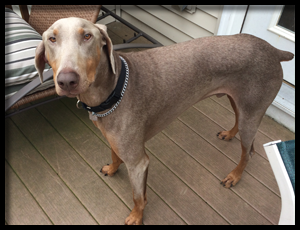
Hand Me Down Dobes is the oldest and largest purebred Doberman rescue in Ohio. Since 1994 our mission has remained the same - to rescue, rehabilitate and place Dobes into loving, forever homes.
We follow the Doberman Pinscher Club of America’s Code of Ethics. For more information visit the DPCA at www.dpca.org.




 Your Dobe needs a place he can call his own– a place where he can retreat and not be bothered by the hustle and bustle of the household, including guests who are eager to spend time with him, and children who are enamored with their new best buddy. Because of this, crate training is in your Dobe’s best interest.
Your Dobe needs a place he can call his own– a place where he can retreat and not be bothered by the hustle and bustle of the household, including guests who are eager to spend time with him, and children who are enamored with their new best buddy. Because of this, crate training is in your Dobe’s best interest. Since Dobes are classified as medium-sized, an extra-large size crate will give him ample room to stand up and turn around without being cramped.
Since Dobes are classified as medium-sized, an extra-large size crate will give him ample room to stand up and turn around without being cramped.